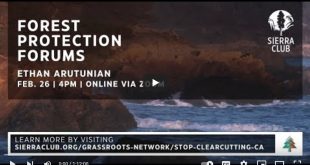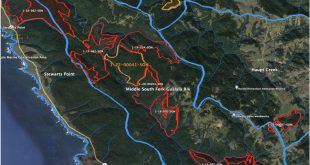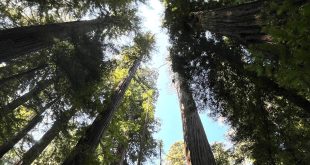on THP 1-00-484 SON – Haupt Creek
| *Original comments are available here. |
May 8, 2003
Forest Practices
California Department of Forestry
135 Ridgeway
Santa Rosa, CA 95401
COMMENTS – THP 1-00- 484SON – Haupt Creek, Wheatfield Fork, Gualala River
ADDITIONAL COMMENTS
As per the Second Review Team / public meeting:
The THP does not recognize or address the current state of the Gualala River as being listed as Temperature Impaired on the States Impaired Water Bodies [303 (d)] list. The lower nine miles of the Gualala River has an excess of 50,000,000 cubic yards (minimum – this figure may be understated) of sediment/aggregate above natural background levels (this figure was corroborated with Tom Spittler – CGS). The lower river is in disequilibrium and can not efficiently handle its sediment load from historic and ongoing sediment source input. Thus far, mitigations in the THP do not give reasonable assurance of limiting the sediment input likely to occur from proposed operations to the point of no impact.
CDF can not legally approve THPs that do not comply with the Basin Plan:
- The Forest Practice Act and the Forest Practice Rules stated objective is consistency with the Porter Cologne Water Quality Control Act.
- Porter Cologne Water Quality Control Act, Water Code Section 13160, states the objective that consistency with the Federal Clean Water Act mandates must be met.
- Under Porter Cologne, the MAA, the Forest Practice Rules, THP administration must meet Basin Plan anti-degradation requirements:
State Anti-degradation Policy (Basin Plan, Chapter 3, Water Quality Objectives):
“Controllable water quality factors shall conform to the water quality objectives contained herein. When other factors result in the degradation of water quality beyond the levels or limits established herein as water quality objectives, then controllable factors shall not cause further degradation of water quality. Controllable water quality factors are those actions, conditions, or circumstances resulting from man’s activities that may influence the quality of waters of the State and that may reasonably be controlled.”
- Forest Practice Rules Section 916.9 (a) (1) states:
(a) “…….Every timber operation shall be planned and conducted to meet the following objectives where they affect a primary limiting factor: (1) Comply with the terms of a Total Maximum Daily Load (TMDL) that has been adopted to address factors that may be affected by timber operations if a TMDL has been adopted, or not result in any measurable sediment load increase to a watercourse system or lake.”
Note: this rule [916.9 (a) (1)] states CDF responsibility to enforce Basin Plan Guidelines as well as TMDL mandates.
919.16
CDF raised question to the RPF under 919.16. The response by the RPF is inadequate, vague, and not supported by either argument or any relevant data. The RPF does not demonstrate preservation of Late Seral characteristics. The claim of 50 year regeneration of LSF is not substantiated. The RPF erroneously denies any impact to LSF.
Given the current status of the file and review the following is still true:
Hydrology
No analysis has been provided regarding effects of the proposed cut on stream hydrology. Dense canopy (see basal area stocking estimates) proposed for removal provides significant water contribution to stream hydrology through fog drip. How will expected canopy loss affect stream hydrology (this must be explained)? Additionally, there are effects on stream hydrology from sediment inputs. These impacts (see sediment discussion in agency documents) must be assessed and mitigated – in compliance with water quality objectives (stated above) and agency concerns stated in the file.
Conclusion
Given evidence in the file, supplied by all Review Team Agency, one could fairly argue that this project, as currently mitigated, poses significant degradation (impact) to the environment.
Loss of LSF needs to be addressed and mitigated. There are also unresolved issues of water quality and fishery habitat impacts not yet addressed. Mitigation of leaving 10 largest trees per 300′ in WLPZ does not fully address LSF or temperature, bank stability, or filtration issues. No harvesting should be allowed in any unstable near stream area or within the steep inner gorge of Haupt Creek. One possible solution is additional reduction of near stream and unstable area cut with retention of more LSF inventory.
Several recommendations were made by Review Team Members. When such recommendation is made to mitigate extensive and ongoing impacts they should be made part of the THP. Failure to do so is a violation of the intent of the Forest Practice Act and not compliant with CEQA. Failure to provide adequate discussion and findings, based in fact, on decision to not include a recommendation is not consistent with CEQA.
Sincerely,
For COAST ACTION GROUP
Alan Levine
Coast Action Group
Box 215
Point Arena, CA 95468
 Friends of Gualala River Protecting the Gualala River watershed and the species living within it
Friends of Gualala River Protecting the Gualala River watershed and the species living within it


